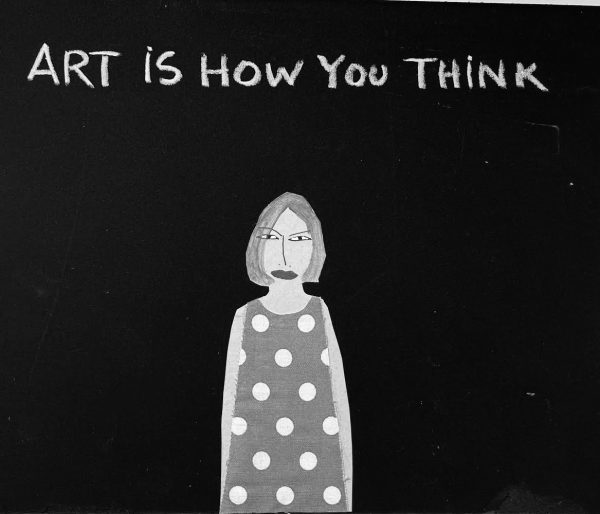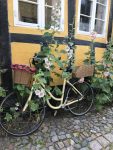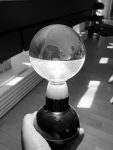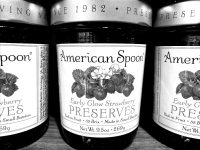Thinking About Art and How We Think
Approaching our work as art can change our worlds

Designer Debbie Millman once wisely shared this life advice: “If you imagine less, less will be what you undoubtedly deserve.” Inverting Debbie’s insight into a more positive frame, I arrive at this: “Imagine ourselves as artists and it’s amazing what can come of it.”
When I think back on all that I’ve learned over the past forty years, I have to laugh. The list of tools, mental shifts, and changes in mindset is long! I knew so little back in 1982. Many of the approaches I’ve adopted have changed my life. Practicing visioning, embracing the power of beliefs, finding open book finance, starting to live servant leadership, creatively applying the tenets of anarchism, and the more recent exploration of the organizational ecosystem metaphor lead the list. Zingerman’s, and my own life, is almost impossible to imagine here in 2022 without them. Although I’ve sometimes given it less attention, the idea of approaching my work and my life as if they were art, poetry, or music has, quietly, been equally impactful.
While the idea of living an artful life had in some sense probably been an intellectual undercurrent for me for quite some time, the idea clicked one day when I was looking at the website of my friend Patrick-Earl Barnes—whose new painting, “Blacks in Culinary,” I wrote about last week. From the day we first met back in 2004, I have been drawn to all of Patrick-Earl’s work. The day I was looking at his website, though, one piece completely caught my attention. It was a painting of one of his classic folk art characters, wearing a t-shirt with the message: “Art is how you think.”
True to his message, Patrick-Earl’s art immediately got me thinking. It was, in essence, an epiphany. The painting took a subconscious, meandering thought I’d been having and framed it in a way I could intentionally and mindfully approach my life. Nearly twenty years later, art is very much how I think, work, look, listen, and live.
Can a small subtle shift like that really make that much difference? For me, the answer is absolutely. Integrating this artful approach to—well, everything—has helped me to see more clearly, deal with the world more effectively, and appreciate everyone and everything around me in a more engaged way. It’s nudged me to notice nuance and to attend more actively and caringly to details I would likely have otherwise missed. The small shifts add up in a big way. As playwright David Mamet put it, “Art is an expression of joy and awe.” When art is how I think, sure enough, to Mamet’s well-made point, I feel joy far more frequently. And, without a doubt, I’m amazed at how often awe shows up in what I might many years ago have mistakenly imagined as mundane.
Seth Godin did a post a while back that sums up this work:
Poets use words (and silence) to change things. They care about form and function and most of all, about making an impact on those that they connect with.
Every word counts. Every breath as well.
In a world filled with empty noise, the most important slots are reserved for the poets we seek to listen to, and the poet we seek to become.
As this approach evolved, and as I began to work at thinking artfully rather than just looking at art, I began, as I so often do, to write about it. A few years after I saw Patrick-Earl’s piece, we published “The Art of Business” pamphlet. Its 30-plus pages are based on the suggestion that no matter what we actually do for a living, we will benefit from starting to imagine ourselves as artists. You can plug in “poets,” or, if you’d prefer, make it “musicians,” or “songwriters,” but the point is the same. When we start to move through our worlds as artists, the shift is easy for an outside eye to miss, but ultimately, the impact can be enormous. Done well over time, thinking and living artfully is life-altering.
“The Art of Business” is based on what I had begun to understand and wrote about in The Power of Beliefs in Business—when we change what we believe, we experience the world differently, we act differently, and others around us are, in turn, impacted, influenced, and inspired in the process. Here’s a snippet of what I suggested at the start of the pamphlet:
Next time someone asks what you do for a living, try telling them you’re an artist. Watch their response. My forecast? They will pay far more attention when you start to share more about your life. So, I’m pretty sure, will you.
. . .
When we choose to live our lives creatively, to make the most of the days and months and years we have on the planet, to be true to ourselves as best we can and as often as possible, then our lives—and our organizations—are truly art as well. Most of us, I know, haven’t conceived of ourselves as artists. But I’m guessing that if we start imagining ourselves in this new light, our lives will likely become richer and more rewarding. Excellent, if imperfect, works of art in the making.
The impact, while subtle, has been significant. It’s pushed me to approach every small interaction I have with the same sort of care and commitment to craft that I work on in my writing. To put as much thought into how I end an email as I do to where to place paragraph breaks when I’m working on a book. Whether I’m greeting a new staff member, working the floor at the Roadhouse, creating an agenda for a meeting, or making dinner, actively thinking as if I were an artist:
-
Pushes me to pay radically more attention. I still slip regularly. But my attentiveness to the world around me has absolutely increased. Artists notice nuance. Many of us have been raised to focus on the finish line; thinking and working more artfully has taught me to tune into and appreciate the process.
-
Helps me call up my creativity all day, every day.
-
Makes me more appreciative. Beauty in the organizational ecosystem metaphor is akin to gratitude—both, I’ve learned, are there to easily be appreciated if we’re paying attention.
-
Gives me a gentle way to raise issues, initiate conversations, and express care and concern; art allows us to do what arguments almost never can.
-
Helps me feel better about myself since I, like most humans, feel at my best when I’m flowing with my creative abilities.
-
Makes my life better by bringing beauty more intentionally to the fore.
Perhaps the most important part of this shift is the realization, the belief, that everyone can do it. This is not about elite experts crafting world-class paintings—it’s about being the world-class human being everyone is capable of becoming. When I do the work well, it’s very much as artist, author, and former physicist Enrique Martínez Celaya writes:
Being an artist is not a posture or a profession, but a way of being in the world and in relation to yourself. An artist is revealed in his or her choices. Watch your actions as well as what you like and notice who is the person suggested by them. Understanding who you are as an artist should be thought of as a life-long process inseparable from your work.
What follows are half-dozen ways that I believe anyone who’s interested can put this into practice. I continue to work to get better at each of them every day.
1. Creatively manage your creative inputs.
If we are, we know, radically influenced by who—or what—we spend the most time with, then it only makes sense that our inherent, naturally occurring artistic abilities will be brought out most by spending more time around art, artful thinkers, and being in creative conversations. As I shared in Secret #39 in Part 3, “It turns out that the biggest thing anyone can do to increase their innovative ability is to go hang around in a creative environment.” This can be in person, on the phone, in our workplace, or in the café we hang out in. It might be in music, books, films, podcasts, going to plays, or reading poetry. The energy and inspiration I get from all that creative connection is a bit like living on solar power. My energy stays high most of the time. It’s much like what musician Rachel Baiman says of music producer Tucker Martine: “He runs his life in service of maintaining inspiration at all times.”
One of the chefs who appears in Patrick-Earl’s art piece is the late Leah Chase who, with her husband, and later, with her children and grandchildren, ran the legendary Dooky Chase restaurant in New Orleans. I’ve had the pleasure of eating in the restaurant, and I had the honor of meeting Leah Chase twice. She was, for me and many others, an inspiration. When you dine at Dooky Chase, you will be surrounded by incredible artworks by some of the country’s best Black painters. Historian and author Jessica Harris, who is also featured in Patrick-Earl’s piece, writes:
While the kitchen may have been her heart, art was her soul: It was a world where she found her true self, and where she delighted in being. The art in Dooky Chase’s restaurant reflects that love and connection.
The little things matter—we can draw inspiration from fresh flowers on the counter or taking a few minutes to read a poem every morning. I keep six vintage Bakelite Scottie-dog-shaped pencil sharpeners in my pocket everywhere I go—one for each of the dogs at our house. When I feel stressed, they serve as grounding, creativity-evoking touchstones. Rachel Baiman said of Tucker Martine’s studio: “Even the bathroom is majestically wallpapered and smells like designer soap. This is an environment in which magic will be made.”
2. Actively find the beauty in everything.
Although I spent much of my life ignoring it, most of the time there is, I’ve come to understand from this work, beauty to appreciate all around me. If we learn to look—or listen, or taste, or touch—as an artist, it’s amazing what we notice. Kazuo Ishiguro says, “An artist’s concern is to capture beauty wherever he finds it.” I saw it in the reflection on the glass bottle of sparkling water that was sitting on the table next to me the other morning while I journaled. I’ve experienced it with the color, aroma, and superfine flavor of the Thorburn’s Terracotta tomatoes that Tammie is growing this year for the first time. Flipping through the most recent Mail Order catalog, I noticed the beauty of Ian Nagy’s amazing illustrations and the craft that went into the placement and the copy. I appreciate that the U.S. Post Office is now selling stamps that feature mariachi musicians. I paused for a few minutes to take in the personalities of the people portrayed in the first wall piece Patrick-Earl did for the Roadhouse in early 2020, and the poster that Ian Nagy did of Patrick-Earl. And I just noticed the other evening—Ian’s poster is on the opposite side of the room, “looking” straight across at Patrick-Earl’s piece. That now makes me smile every time I enter the room!
3. Artfully make a difference.
Great art in this context is not for decoration; it’s about making a meaningful difference. Playwright Aaron Sorkin says, “If you feel that strongly about something, you have an obligation to try and change my mind.” Artful action—whether it’s in a painting or in person—draws us in. This is, in great part, why my eye went to Patrick-Earl’s paintings in the first place when I saw him selling them on Spring Street in Soho nearly twenty years ago, why I walked over to look more closely, and why I bought three of them to carry home in my luggage. It’s what made me want to hang his art—alongside the amazing work of Ian Nagy and Ryan Stiner—in the Roadhouse. It’s absolutely what gave me the thought to commission the new “Blacks in Culinary” piece. We can make a difference in people’s lives, and bring beauty to our communities. Elizabeth Catlett, whose painting of Leah Chase is now hanging in the Smithsonian, once said, “We have to create an art for liberation and for life.”
3. Be more attentive to what’s happening in your head and your heart.
If I don’t keep myself centered, it’s unlikely my art will be effective in its impact. Journaling, as I wrote about in “Working Through Hard Times,” has been a huge help. Running every day nearly always brings unexpected insights. Talking to friends, teaching, reading, etc. all help me tune into what’s in my heart. The folks at Indigenous Resistance write about the importance of “taking care of one’s inner dub in order to the work of the outer dub.” Managing Ourselves (which we really, really hope will get past the paper supply chain issues soon!) has 400-plus pages of my thoughts on this broad and important subject.
4. Go for mindful greatness.
No artist wants to put out below-average art. No poet calmly settles for so-so. Tucker Martine says, “If we aren’t doing this to make the best record that we can, then what’s the point?” When art is how I think, I take that mindset into every small interaction I have—taking time to thank the postal carrier with a heartfelt smile. To add a bit more meaningful appreciation to what starts out to be an otherwise mundane email. To listen more closely when someone tells me their name so that I actually remember it in the understanding that even our brief introduction can be done superficially, or, instead, with an artful intent to attain excellence in the exchange.
5. Nurture other artists.
The other day I got interviewed by Jonathan Fields on the Good Life Project podcast. At the end of the conversation, he always asks, “What does living a good life mean to you?” I began my answer by referring back to many of the things we had talked about—increasing hope, enhancing positive beliefs, paying attention to purpose, etc. A sentence or two into my response though, I realized the obvious answer I was working my way back to: “Living a good life is helping other people to live a good life.” Sharing this approach with everyone, noticing the beauty in their work, and encouraging them to do the same with their own surroundings, helps a lot. As Seth Godin says, “Art isn’t painting or canvas or prettiness. Art is work that matters.” The amazing, difference-making artist Samella Lewis, who passed away earlier this year at the age of 99, was mentored as a young woman by Elizabeth Catlett who was eight years her senior. Who can we help this week to see themselves through this sort of artful lens?
6. Make a positive difference.
Elie Wiesel writes, “The opposite of love is not hate, it’s indifference. The opposite of art is not ugliness, it’s indifference.” The point of this piece is, ultimately, to help enable anyone interested to make their life richer, their ecosystem more connected and caring, and to tap into their creativity and purpose more purposefully. Despite laws that said it couldn’t happen, the upstairs at Dooky Chase became the first integrated restaurant in New Orleans. And as Leah Chase said, “In my dining room, we changed the course of America over a bowl of gumbo and some fried chicken.”
Approaching our work and our lives as artists is not in conflict with doing what we need to do to make a living. The key is that we do it in ways that are true to us, true to our values, infused with dignity, and done daily with grace. Here’s a snippet of a bit from “The Art of Business”:
Poet Gary Snyder came to visit Ann Arbor a few months ago for a reading. He’s studied Japanese drawing and Chinese poetry, and he used to hang out with Allen Ginsberg and Jack Kerouac. He’s been called “the poet laureate of deep ecology,” does environmental work, and has also published a good bit of insightful prose, including an essay that particularly resonated with me called “Buddhist Anarchism.” As I write, he’s in his 85th year. He was born ten months after Robert Henri died. I’m honored that Gary chose to eat at the Roadhouse (as he did on his previous visit as well) on the evening of the event. Over 500 people came to hear him read poetry on a farm 10 miles west of town. Wow. Snyder shared his belief that “[c]ommercial art is when you do something to respond to a demand in the marketplace. That’s not a bad thing. But when you do something because it’s what you love, and then you figure out how to get people to buy it, even though they didn’t know they wanted it until you made it, now that’s really great art.” It’s what we’ve tried to do here at Zingerman’s for 34 years now.
The poet Guante says, “Don’t write a poem about war. Write a poem about what it’s like to stand in your brother’s empty bedroom.” When I’m engaging with the world as an artist, it reminds me to look more closely, notice more, hear more, and in a regenerative way, do better. It pushes me to see not just at the plate of food being served to the guest but to focus equally on the energy of the person who’s putting it down in front of them.
What we know now about neuroplasticity makes clear that this artful approach, practiced regularly over a period of years, will literally change our minds. Not only will that change help us, and those around us, it also serves to help inoculate us against the fear, negativity, and unnecessary drama that dominates so much of the world’s daily conversation. As scientist Norman Doidge describes, “Once a particular plastic change occurs in the brain and becomes well-established, it can prevent other changes from occurring. It is by understanding both the positive and the negative effects of plasticity that we can truly understand the extent of human possibilities.”
In the urgency of the world’s current crises, it would be easy to ignore this call for thinking and acting more artfully. I could have walked right past Patrick-Earl selling his paintings in Soho all those years ago. But look at the impact of that seemingly small decision to honor my instinct, to engage artfully with his art, and to build a friendship and find ways to connect creatively and caringly. Every person we see, every interaction we have, has the potential to also make this kind of difference. These acts of artfulness get little attention from others, but they might just save the planet.
John O’Donohue wrote many years ago that the world was suffering from a crisis of ugliness: “In a sense, all the contemporary crises can be reduced to a crisis about the nature of beauty.” Stepping back and working at approaching our lives and work like artists or poets or painters helps us to gain much-needed perspective. “Perhaps,” O’Donohue says, “for the first time we gain a clear view of how much ugliness we endure and allow.” I don’t have any statistics to prove it, but I’m confident that there are more artfully-minded folks doing good work in the world, and that most of those doing ill (though I know not all) are not spending time on palindromes, poems, or careful selection of paint colors.
Learning to think in artful terms has shifted the way I see the world, and I hope, through that shift, also altered my impact for the better as well. Dooky Chase has posters on the wall by the artist Jacob Lawrence. Leah Chase told Jessica Harris:
I learned to look at his work, and from there on, I just learned to look at things. Sometimes you don’t understand it. Sometimes you look at it, you say, “Oh my goodness, this is so ugly.” Look again. Look again and you’ll see something.
Chase’s artfully spoken comments reminded me to return my attention to the ending of “The Art of Business,” where I shared a similar lesson from a story that James Baldwin told, a story that took place maybe a mile to the west of where I first met Patrick-Earl:
I remember standing on a street corner with the black painter Beauford Delaney down in the Village waiting for the light to change, and he pointed down and said, ‘Look.’ I looked and all I saw was the water. And he said, ‘Look again,’ which I did, and I saw oil on the water and the city reflected in the puddle. It was a great revelation to me. I can’t explain it. He taught me how to see, and how to trust what I saw. Painters have often taught writers how to see. And once you’ve had that experience, you see differently.” Baldwin’s story sticks in my head. Every time I start to skip past something unthinkingly, I try to turn my mind back to look—or listen, or taste—again, to see what I missed the first time around. It’s amazing how much more interesting the world gets when we take the time to pay careful attention. Beauty begins to appear in the most unexpected places.
If you’d like to purchase a bunch of copies of “The Art of Business” pamphlet to get your organization moving in a more artful direction, email Jenny at [email protected].
Want more from Ari?
Sign up for Ari’s Top 5 e-newsletter and look forward to his weekly curated email—a roundup of 5 Zing things Ari is excited about this week—stuff you might not have heard of!




Zingerman’s Art for Sale